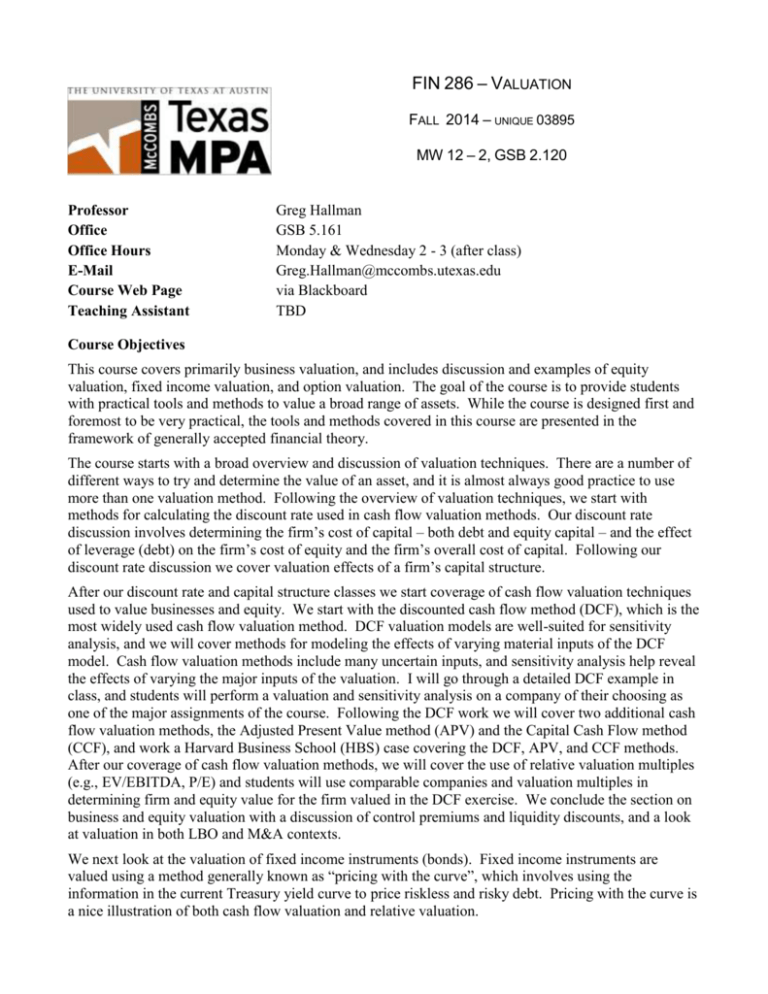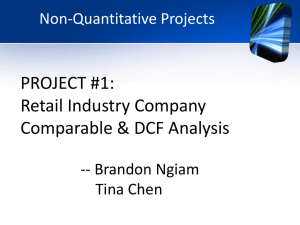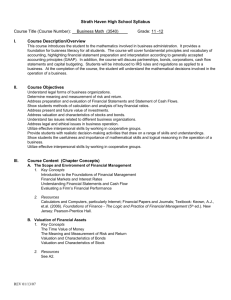
FIN 286 – VALUATION
FALL 2014 – UNIQUE 03895
MW 12 – 2, GSB 2.120
Professor
Office
Office Hours
E-Mail
Course Web Page
Teaching Assistant
Greg Hallman
GSB 5.161
Monday & Wednesday 2 - 3 (after class)
Greg.Hallman@mccombs.utexas.edu
via Blackboard
TBD
Course Objectives
This course covers primarily business valuation, and includes discussion and examples of equity
valuation, fixed income valuation, and option valuation. The goal of the course is to provide students
with practical tools and methods to value a broad range of assets. While the course is designed first and
foremost to be very practical, the tools and methods covered in this course are presented in the
framework of generally accepted financial theory.
The course starts with a broad overview and discussion of valuation techniques. There are a number of
different ways to try and determine the value of an asset, and it is almost always good practice to use
more than one valuation method. Following the overview of valuation techniques, we start with
methods for calculating the discount rate used in cash flow valuation methods. Our discount rate
discussion involves determining the firm’s cost of capital – both debt and equity capital – and the effect
of leverage (debt) on the firm’s cost of equity and the firm’s overall cost of capital. Following our
discount rate discussion we cover valuation effects of a firm’s capital structure.
After our discount rate and capital structure classes we start coverage of cash flow valuation techniques
used to value businesses and equity. We start with the discounted cash flow method (DCF), which is the
most widely used cash flow valuation method. DCF valuation models are well-suited for sensitivity
analysis, and we will cover methods for modeling the effects of varying material inputs of the DCF
model. Cash flow valuation methods include many uncertain inputs, and sensitivity analysis help reveal
the effects of varying the major inputs of the valuation. I will go through a detailed DCF example in
class, and students will perform a valuation and sensitivity analysis on a company of their choosing as
one of the major assignments of the course. Following the DCF work we will cover two additional cash
flow valuation methods, the Adjusted Present Value method (APV) and the Capital Cash Flow method
(CCF), and work a Harvard Business School (HBS) case covering the DCF, APV, and CCF methods.
After our coverage of cash flow valuation methods, we will cover the use of relative valuation multiples
(e.g., EV/EBITDA, P/E) and students will use comparable companies and valuation multiples in
determining firm and equity value for the firm valued in the DCF exercise. We conclude the section on
business and equity valuation with a discussion of control premiums and liquidity discounts, and a look
at valuation in both LBO and M&A contexts.
We next look at the valuation of fixed income instruments (bonds). Fixed income instruments are
valued using a method generally known as “pricing with the curve”, which involves using the
information in the current Treasury yield curve to price riskless and risky debt. Pricing with the curve is
a nice illustration of both cash flow valuation and relative valuation.
FIN 286 – Valuation – Fall.1 2014
Hallman
page 2
The course concludes with an example of no-arbitrage pricing in financial asset markets. Using a
binomial framework we will price a call option and look at the trading opportunities afforded by
mispriced options. No-arbitrage pricing is a powerful tool for deriving the value of financial assets and
can be used as a guide for the value of any asset.
Materials
Required Text (available at the Co-op)
Valuation: The Art & Science of Corporate Investment Decisions, by Sheridan Titman and John
Martin, Prentice Hall, 2 edition, 2010.
Required HBS Case material (I will have an HBS reading packet for sale at the copy center ~$10)
An Introduction to Cash Flow Valuation Methods – HBS Note #9-295-155
Sampa Video, Inc. – HBS Case #9-201-094
Optional Texts (available online at Amazon and other sites)
Fixed Income Securities, Bruce Tuckman, 2nd Edition, 2002, John Wiley & Sons.
Jonathan Berk and Peter DeMarzo: Corporate Finance. Pearson, Addison Wesley, 3rd edition.
Course Requirements and Grading
Your grade in the course will be determined as follows:
In-Class Contribution
Discount Rate problem set
DCF Valuation exercise
Comps Valuation exercise
HBS Sampa Case
Final Exam
Points
5
10
20
10
5
50
100
Make-up and extra-credit assignments are generally not possible. Your grade will be determined solely
by the components listed above. Regarding class attendance, because there are only 14 meetings, if you
miss four or more classes I reserve the right to fail you so that you can take the class at a later date when
it might be more convenient for you.
Hallman
FIN 286 – Valuation – Fall.1 2014
page 3
McCombs Classroom Professionalism Policy
The highest professional standards are expected of all members of the McCombs community. The
collective class reputation and the value of the Texas MBA/MPA experience hinges on this.
Faculty are expected to be professional and prepared to deliver value for each and every class session.
Students are expected to be professional in all respects.
The Texas MBA/MPA classroom experience is enhanced when:
Students arrive on time. On time arrival ensures that classes are able to start and finish at the
scheduled time. On time arrival shows respect for both fellow students and faculty and it enhances
learning by reducing avoidable distractions.
Students display their name cards. This permits fellow students and faculty to learn names,
enhancing opportunities for community building and evaluation of in-class contributions.
Students minimize unscheduled personal breaks. The learning environment improves when
disruptions are limited.
Students are fully prepared for each class. Much of the learning in the Texas MBA/MPA program
takes place during classroom discussions. When students are not prepared they cannot contribute to
the overall learning process. This affects not only the individual, but their peers who count on them,
as well.
Students attend the class section to which they are registered. Learning is enhanced when class
sizes are optimized. Limits are set to ensure a quality experience. When section hopping takes place
some classes become too large and it becomes difficult to contribute. When they are too small, the
breadth of experience and opinion suffers.
Students respect the views and opinions of their colleagues. Disagreement and debate are
encouraged. Intolerance for the views of others is unacceptable.
Laptops are closed and put away. When students are surfing the web, responding to e-mail, instant
messaging each other, and otherwise not devoting their full attention to the topic at hand they are
doing themselves and their peers a major disservice. Those around them face additional distraction.
Fellow students cannot benefit from the insights of the students who are not engaged. Faculty office
hours are spent going over class material with students who chose not to pay attention, rather than
truly adding value by helping students who want a better understanding of the material or want to
explore the issues in more depth. Students with real needs may not be able to obtain adequate help if
faculty time is spent repeating what was said in class. There are often cases where learning is
enhanced by the use of laptops in class. Faculty will let you know when it is appropriate to use them.
In such cases, professional behavior is exhibited when misuse does not take place.
Phones and wireless devices are turned off. We’ve all heard the annoying ringing in the middle of
a meeting. Not only is it not professional, it cuts off the flow of discussion when the search for the
offender begins. When a true need to communicate with someone outside of class exists (e.g., for
some medical need) please inform the professor prior to class.
Hallman
FIN 286 – Valuation – Fall.1 2014
page 4
Academic Dishonesty
I have no tolerance for acts of academic dishonesty. Such acts damage the reputation of the school and
the degree and demean the honest efforts of the majority of students. The minimum penalty for an act of
academic dishonesty will be a zero for that assignment or exam.
The responsibilities for both students and faculty with regard to the Honor System are described on
http://mba.mccombs.utexas.edu/students/academics/honor/index.asp. As the instructor for this course, I
agree to observe all the faculty responsibilities described therein. If the application of the Honor System
to this class and its assignments is unclear in any way, it is your responsibility to ask me for
clarification.
As specific guidance regarding collaboration for this course, you should consider the completion of the
three individual problem sets to be an individual effort. It is OK to ask for help from others on the
individual assignments if you get completely stuck or lost, however, you should develop your own
answer and certainly not cut and paste the work of others. The HBS Sampa case assignment can be
completed individually, or in pairs. Group preparation for examinations is acceptable and encouraged.
Students with Disabilities
Upon request, the University of Texas at Austin provides appropriate academic accommodations for
qualified students with disabilities. Services for Students with Disabilities (SSD) is housed in the Office
of the Dean of Students, located on the fourth floor of the Student Services Building. Information on
how to register, downloadable forms, including guidelines for documentation, accommodation request
letters, and releases of information are available online at
http://deanofstudents.utexas.edu/ssd/index.php. Please do not hesitate to contact SSD at (512) 471-6259,
VP: (512) 232-2937 or via e-mail if you have any questions.
FIN 286 – Valuation – Fall.1 2014
Hallman
page 5
FIN 286 – Valuation – Hallman – Fall.1 2014 Schedule
class
Topic
1
Introduction and Discussion of Valuation Techniques Discounted Cash Flow (DCF), Trading and Transaction
Comparables and Multiples, Cost Approach
material
day
Wed
date
20-Aug
Fri
22-Aug
2
Calculating the Discount Rate The CAPM, The CAPM with Size, Fama-French 3 factor model,
the cost of debt, WACC, calculating and unlevering and
re-levering beta, adjusting for international risk
Mon
25-Aug
3
Finish Discount rate discussion, beta regression calculation
example. assign discount rate problem set, due Friday,
Aug 29, 6th floor, or you can bring it Wednesday
Wed
27-Aug
4
Capital Structure and Financial Leverage Effects of Capital Structure on Value:
M&M, Tax Effects and Costs of Financial Distress
Mon
1-Sep
Wed
3-Sep
5
Valuing a Company with the DCF method –
in-class example valuation of Campbell’s Soup
assign DCF Valuation problem set, due Wed, Sept 10
Titman & Martin,
C's 2, 3, 6 & 9
Mon
8-Sep
6
DCF Sensitivity Analysis including scenario analysis, breakeven, and Monte-Carlo simulation with @Risk.
Titman & Martin,
C's 2, 3, 6 & 9
10-Sep
7
A broader look at cash flow valuation and keeping track of the
tax shield from debt: Capital Cash Flows, Firm Cash Flows,
Equity Cash Flows, WACC, and the APV
DCF valuation DUE
assign Sampa Video case for in-class Monday, Sept 15
Sampa case can be worked in pairs if you prefer
HBS Ruback CCF
paper
Mon
15-Sep
8
HBS APV Valuation Case - Sampa Video
Case answers to Sampa questions due in class;
we’ll work the answers out on the board in class
Wed
17-Sep
9
Valuing a company with comparables and multiples
Wed
Titman & Martin,
C4
Berk & DeMarzo,
C's 14, 15 & 16
LABOR DAY – NO CLASS
Titman & Martin
C8
FIN 286 – Valuation – Fall.1 2014
Hallman
date
class
22-Sep
10
Comps Day 2 – Campbell’s comp example with comparison
back to DCF results for Campbell’s value
Wed
24-Sep
11
Additional Topics - Control Premiums & Liquidity Discounts,
valuing LBOs and M&A transactions, earnings accretion and
dilution in M&A transactions
Mon
29-Sep
12
Selected student valuation presentations – Student pairs will
be prepared to give a short 5-10 minute presentation on their
valuations using both DCF and comps and argue a final answer
for value, much like I will do on Monday, September 22, for my
Campbell’s Soup class example.
Wed
1-Oct
13
Valuation of Fixed Income Instruments - in-class example
including bootstrapping a Treasury curve, pricing Treasury debt
with a bootstrapped curve, solving for static and zero-volatility
spreads on risky debt, pricing and analyzing risky debt with
spread measures
Tuckman C's 1-4
optional text
Mon
6-Oct
14
The valuation of options and a close look at no-arbitrage
pricing in a binomial option framework
Berk & DeMarzo,
C’s 20 & 21
Wed
8 –Oct
15
Course Review and exam prep for exam on Friday Oct 10
Friday
10-Oct
day
Mon
Topic
page 6
FINAL EXAM
material
Titman & Martin,
C's 7 & 10








